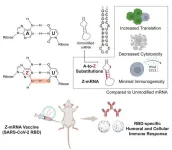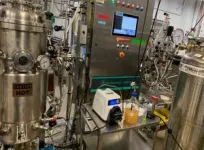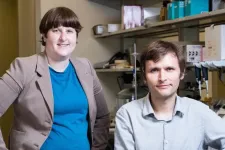(Press-News.org)
Messenger RNA (mRNA) technology has become popular in the last few years due to its use in COVID-19 vaccines. This technology has been so groundbreaking that it recently won the 2023 Nobel Prize in medicine “for discoveries concerning nucleoside base modifications that enabled the development of effective mRNA vaccines against COVID-19.” This isn’t new technology, however— modified mRNAs have been studied for decades and show significant potential for therapeutic applications. Compared to unmodified mRNAs, modified mRNAs are more stable and have more favorable immunogenic effects.
A team of researchers from the University of Illinois Urbana-Champaign have incorporated a newly discovered base, called base Z (2-aminoadenine), into mRNA to create Z-mRNA that has improved translational capacity, decreased cytotoxicity and drastically reduced immunogenicity compared to unmodified mRNA.
The results from this new research, led by chemical and biomolecular engineering professor Huimin Zhao, former chemical and biomolecular engineering graduate student Meng Zhang (current postdoc at Stanford University), and postdoc Nilmani Singh (Carl R. Woese Institute for Genomic Biology), were recently published in the journal iScience.
“We incorporated base Z into mRNA, and we wondered whether it would perform better than the current modified mRNA vaccine platform,” says Zhao.
mRNA is a macromolecule that is transcribed from DNA and contains the instructions for protein production in cells. For use in vaccines, the mRNA is used to encode the antigen that triggers an immune response in human bodies. This way, the body is “trained” to fight off certain viruses and if infected with the real thing, the body can recognize it and produce the necessary antibodies.
Unmodified mRNA contains four bases—A, G, C and U. In this research, base A was replaced with base Z, which can form three hydrogen bonds, a weak bond between two molecules from an attraction of positive and negative charges, with base U (unlike two hydrogen bonds formed between typical A:U pairing). Moreover, base Z differs from other modified bases because it does not come from the human body. “Traditional wisdom is that modified bases should ideally come from the human body so that any mRNA modified by such a base would mimic mRNA in the human body and bypass immune surveillance,” Zhang says.
Despite not naturally existing in the human body, base Z mRNA still demonstrated low immunogenicity—the ability of cells to provoke an immune response and generally considered to be an undesirable physiological response—and reduced cytotoxicity (causing cell death) when tested in cultured cells. While mRNA-based vaccines in general induce lower immune responses, many people still experience some sort of immune reaction. “Having an mRNA vaccine alternative with less side effects would be a really big deal,” says Singh.
To demonstrate the application of their Z-mRNA in vivo, the team developed a Z-mRNA-based COVID-19 vaccine. They tested this Z-mRNA vaccine, alongside the modified mRNA vaccine used by Moderna and Pfizer, in mice, and they found that the Z-mRNA vaccine could induce a substantial and antigen-specific immune response. Although the potency of the Z-mRNA vaccine was not as strong as the current standard, the team believes Z-mRNA could be further improved through systematic engineering efforts.
“The biggest implication of this work is that people don’t have to be limited by those modifications that are naturally present in our body, it is possible to choose modifications outside of our body, but that can still give the desired biological effects such as reduced immunogenicity and enhanced translational ability,” says Zhang.
“We proved that our new modified mRNA vaccine has reduced cytotoxicity and also minimal immunogenicity, which has been a problem in the past for mRNA-based therapies,” says Zhao. “mRNA-based therapeutics are a hot area currently. Not just for vaccine applications, but even for cancer treatments. We want to take advantage of the unique features of Z-containing mRNA for other therapeutic applications.”
*
Huimin Zhao is also an affiliate of the Department of Chemistry, the Department of Biochemistry, and the Department of Bioengineering at UIUC.
Other contributors to this work include Mary Elisabeth Ehmann (Department of Chemical and Biomolecular Engineering at the University of Illinois at Urbana-Champaign) and Lining Zheng (Department of Materials Science and Engineering at the University of Illinois at Urbana-Champaign).
This research was funded by the Steve L. Miller Endowed Chair fund and partly by the U.S. National Institutes of Health.
https://doi.org/10.1016/j.isci.2023.107739
END
Abdolhossein Haji-Sheikh, a retired professor in the Mechanical and Aerospace Engineering Department at The University of Texas at Arlington, has made a $500,000 gift to support his former department.
The gift creates an endowed professorship in heat transfer, one of Haji-Sheikh’s areas of expertise during his decades of teaching at UTA. The professorship will be awarded in 2026.
Haji-Sheikh began his career at what was then Arlington State College in 1966. He said he wants to give back to ...
Inventor of xenobots unveils new advance toward artificial life
New AI algorithm compresses billions of years of evolution into seconds
The evolved robot has three legs and rear fins, something a human engineer would never devise
Researcher: ‘Now anyone can watch evolution in action as AI generates better and better robot bodies in real time.’
A team led by Northwestern University researchers has developed the first artificial intelligence (AI) to date that can intelligently design robots from ...
Two Rice University bioengineers received the National Institutes of Health (NIH) Director’s New Innovator Award (NIA) for creative research projects demonstrating broad impact potential.
Part of the High-Risk, High-Reward Research program, NIA awards support early-career investigators with ambitious, unconventional project proposals “in any area of biomedical, behavioral or social science research relevant to the NIH mission,” according to the agency’s website.
Rice’s ...
Cancer-related fatigue (CRF) is a debilitating yet all-too-common condition, which can severely affect quality of life for patients undergoing treatment. For those struggling with CRF, there have been no effective pharmaceutical treatments for the constellation of symptoms that together define the syndrome.
In a new study led by Yale Cancer Center researchers at Yale School of Medicine, the team found that a metabolism-targeting drug called dichloroacetate (DCA) helped alleviate CRF in mice, without interfering with cancer ...
Effective September 26, 2023, NRG Oncology-RTOG 1308, a phase III randomized trial comparing overall survival after photon versus proton chemoradiotherapy for patients with inoperable stage II-IIIB non-small cell lung cancer (NSCLC) has met its accrual target. The trial, one of several NRG Oncology ongoing clinical trials across various malignancies within the National Clinical Trials Network (NCTN) that compare photon versus proton radiation therapy techniques, is the first phase III head-to-head comparison of these ...
Even as the world slowly begins to decarbonize industrial processes, achieving lower concentrations of atmospheric carbon requires technologies that remove existing carbon dioxide from the atmosphere — rather than just prevent the creation of it.
Typical carbon capture catches CO2 directly from the source of a carbon-intensive process. Ambient carbon capture, or “direct air capture” (DAC) on the other hand, can take carbon out of typical environmental conditions and serves as one weapon in the battle against climate change, particularly as reliance ...
Dr. Tanya Stoyanova, associate professor of molecular and medical pharmacology and urology at the David Geffen School of Medicine at UCLA, was awarded a $350,000 Idea Development Award from the Department of Defense.
The award will help Stoyanova, a member of the UCLA Jonsson Comprehensive Cancer Center, to identify new cancer detection and treatment strategies for small cell lung cancer, a highly aggressive form of the disease that accounts for approximately 15% of lung cancers. Known for spreading quickly, most people diagnosed with the disease face low chances of survival beyond five years.
The award ...
Carol L. Silva, the Edith Kinney Gaylord Presidential Professor of Political Science in the Dodge Family College of Arts and Sciences and Senior Associate Vice President for Research and Partnerships at the University of Oklahoma, has been elected a 2023 fellow of the National Academy of Public Administration.
“Carol is an experienced, dynamic leader with an extensive record of excellence in research and building successful multidisciplinary programs and convergent teams focused on grand challenge problems at the intersection of public policy and technology. We congratulate her on this election to the NAPA and look forward to the impact she will make among these national thought ...
Large health systems are acquiring smaller physician practices at what some consider an alarming rate, leaving fewer independent practices. When the COVID-19 pandemic occurred, it was unclear whether the independent practices would be able to “keep up” (maintain the same level of patient care) with larger practices, which have more resources, and if care for patients with chronic conditions might be disrupted by the pandemic.
A new study from Associate Dean of Research Alison Cuellar found that independent practices experienced a smaller drop in patient volume than ...
The Gerontological Society of America (GSA) invites all journalists to attend its 2023 Annual Scientific Meeting — the country’s largest interdisciplinary conference in the field of aging — from November 8 to 12 in Tampa, Florida. Qualified media representatives intending to cover the meeting may register free of charge.
More than 3,000 professionals are expected to attend the five-day gathering at the Tampa Convention Center. The theme for 2023 is “Building Bridges > Catalyzing Research > Empowering All Ages,” and the program schedule contains ...







